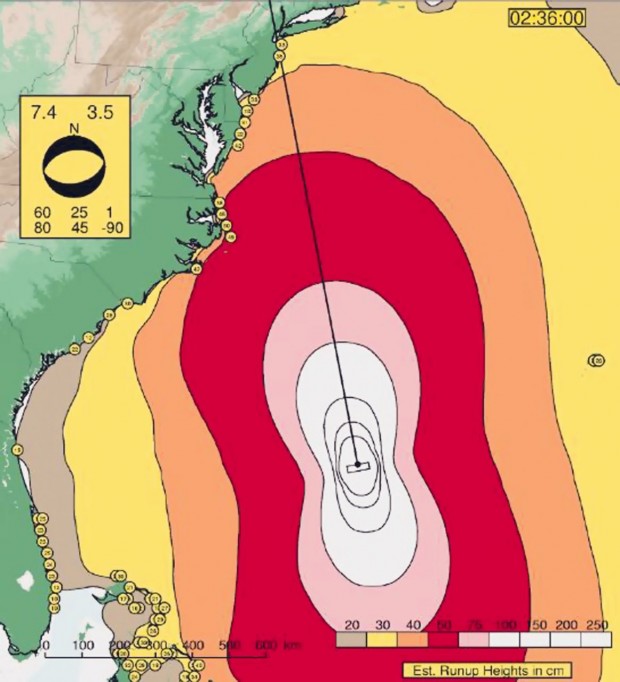New Research: 1817 Bermuda Quake/Tsunami
According to popular newspapers published at the time, a huge “tidal wave” sent ships docked along the Delaware River in the United States for a ride in the late morning of January 8, 1817, giving local residents a fright and leaving all who experienced the phenomenon wondering exactly why it had occurred.
Now, nearly 200 years later, scientific research appears to have cracked the case of the mysterious tidal wave, identifying it instead as a true tsunami and pointing a finger at the Bermuda Triangle as the culprit behind it all.
A new study lead by geophysicist Susan Hough of the United States Geological Survey (USGS) shows that the ocean-based occurrence was actually the result of a powerful magnitude-7.4 earthquake that originated earlier that morning near the northern tip of the area popularly called the Bermuda Triangle.
Computer image showing the predicted epicentre of the 1817 earthquake (courtesy Susan Hough, USGS):
The quake’s effects were felt along the American east coast, with scientists there recording the ground’s trembling in logs and journals, leading them to estimate the earthquake’s magnitude at only about a 4.8 on the Richter Scale; by contrast, a 7.4-magnitude quake releases nearly 8,000 times more energy. At the time, the epicentre of the quake was simply unknown.
Now, using modern technology and its ability to extrapolate outcomes based on key data points, Hough and her team have been able to put their geological detective work to good use, utilizing previously unknown archival records from Bermuda and settlements on the American east coast in order to gauge where the earthquake’s effects were strongest, helping them to eventually pin down the epicentre.
The Tsunami Puzzle
More tricky for the team was figuring out how the tsunami fit into the puzzle; at first glance, the apparent 4am EST occurrence of the earthquake simply didn’t correspond with the 11am EST occurrence of the tsunami’s effects along the Delaware River, given that the tsunami would be expected to travel substantially faster than those numbers indicated.
To solve this problem, the researchers implemented a computer model to predict the oceanic effects of a quake in the region, finding that it was the Delaware River itself that slowed the tsunami’s wave down, helping them to account for what had, at first glance, appeared to be lost time.
With complaints from her colleagues that the proposed Bermuda Triangle connection was “hooey,” Hough and her team pressed forward in trying to determine the cause of the quake.
With no obvious fault lines in the area, alongside a very unpredictable history of seismic activity in the Atlantic, there are no obvious connections, but Hough is committed to eventually filling in as many of the holes in the Atlantic Ocean’s geological history as possible, Bermuda Triangle and all.



Whoa